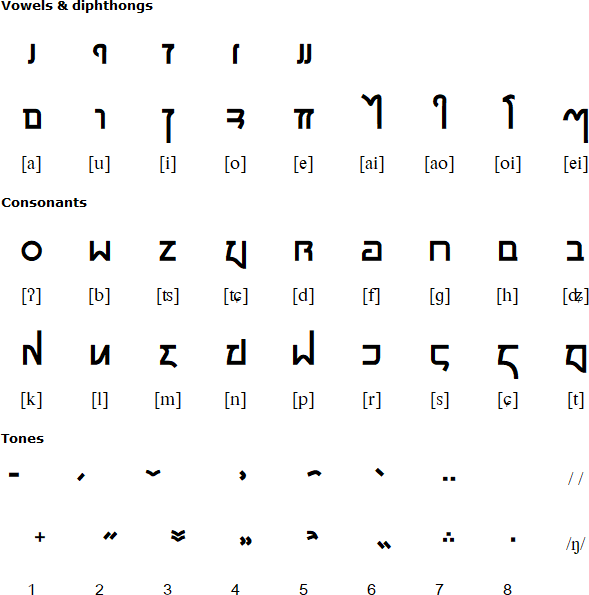
The Hoelāı script was invented by Miles Forster in 2019 to write Toaq, a language he also constructed. It was created partially to give an identity to the language. The script draws inspiration from the Thai, Tibetan and Hebrew’s scripts. The image on the right is a calligraphy version of the script's name.

Download a script chart for Hoelāı (Excel)
The fullest Toaq syllable may have a consonant, two nuclear components, and a coda /ŋ/. In the Toaq script there are 18 consonantal glyphs one of them being a placeholder, 15 tonal glyphs that represent both the tone of a syllable and presence/absence of a coda /ŋ/, and 14 vocalic glyphs. 10 are for the five monophthongs, which each have two different forms depending on whether they are written before or after a consonant, and four are for the diphthongs ai, ao, oi, and ei, and they are always written before a consonant.
Nuclei are split into two slots with the first component written after the consonant and the second component after. An example would be "h-o-aı" which in the script would be written aı-h-o. Notice the consonant is in the center and the second component of the nucleus, a diphthong in this case, is written before said consonant.
Tones and the presence/absence of coda /ŋ/ are both encoded into one of 15 diacritics which are placed on the initial consonant. There are 7 tones and one nuetral tone, giving 7 diacritics because the neutral tone isn't marked if there is no coda. These are doubled semi-productively to encode the presence of coda /ŋ/.
For the neutral tone with a coda /ŋ/, the diacritic is a superposed point. Sóe, meaning "the sour thing," would be written eśo, and kěaı, meaning "which has the right to...," as aıǩe.

Tu tủq rẻq bòı jîu hó pa shẻı na ru chẻo jẻq lî dỏıdēaı ru lî kẻaı ja hı rảı da. Rỏabō hó lî dẻq kủımōı ru lî chỉaq da. Chẻo tỏı hó chà hê chẻo tỏı báq pỉachēo ba.
A recording of this text by David Douglass
All human beings are born free and equal in dignity and rights. They are endowed with reason and conscience and should act towards one another in a spirit of brotherhood.
(Article 1 of the Universal Declaration of Human Rights)
See the Hoelāı script in action:
Constructed scripts for: Ainu | Arabic | Chinese languages | Dutch | English | Hawaiian | Hungarian | Japanese | Korean | Lingala | Malay & Indonesian | Persian | Tagalog / Filipino | Russian | Sanskrit | Spanish | Taino | Turkish | Vietnamese | Welsh | Other natural languages | Colour-based scripts | Tactile scripts | Phonetic/universal scripts | Constructed scripts for constructed languages | Adaptations of existing alphabets | Fictional alphabets | Magical alphabets | A-Z index | How to submit a constructed script
[top]
You can support this site by Buying Me A Coffee, and if you like what you see on this page, you can use the buttons below to share it with people you know.

If you like this site and find it useful, you can support it by making a donation via PayPal or Patreon, or by contributing in other ways. Omniglot is how I make my living.
Note: all links on this site to Amazon.com, Amazon.co.uk
and Amazon.fr
are affiliate links. This means I earn a commission if you click on any of them and buy something. So by clicking on these links you can help to support this site.
[top]